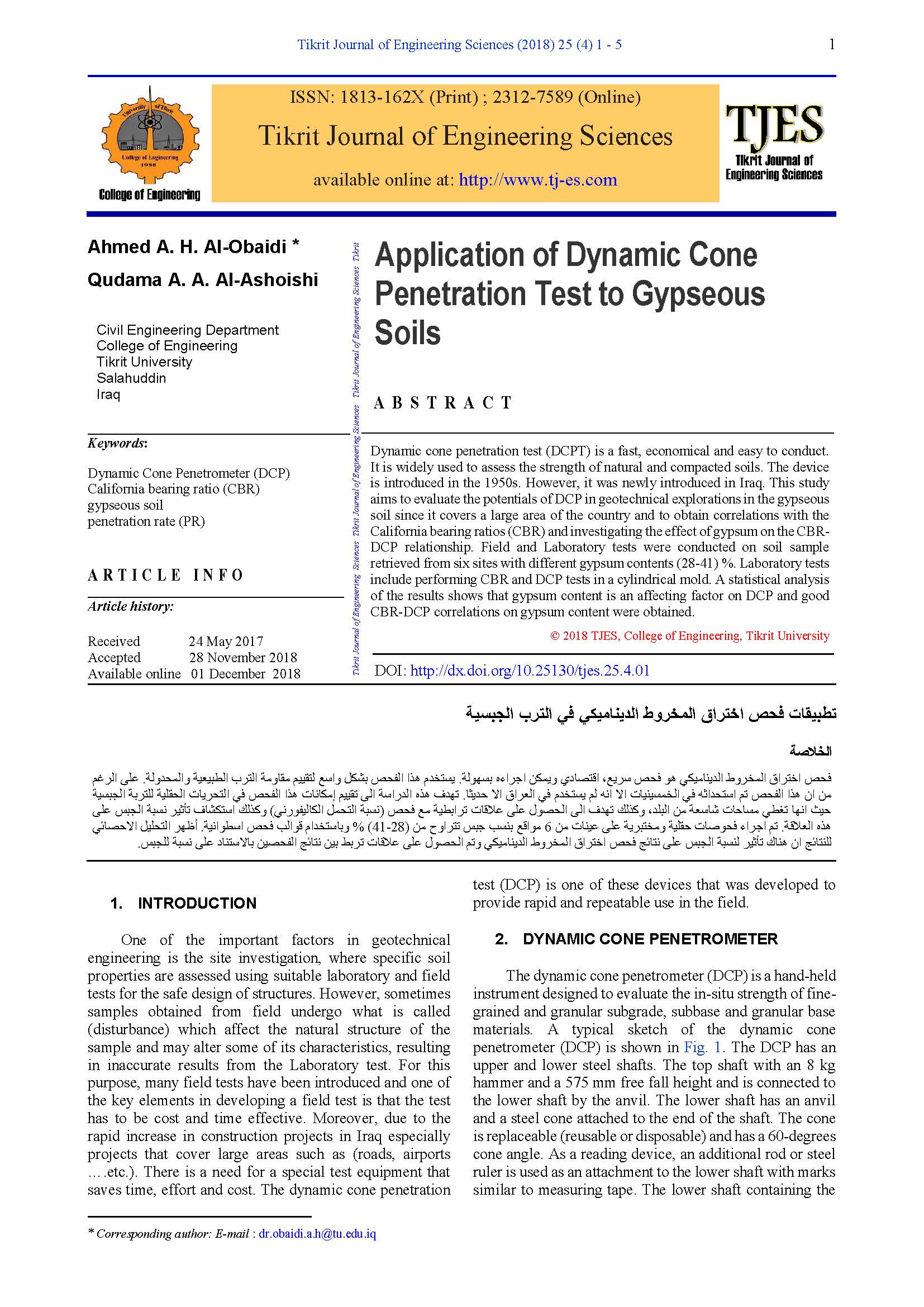Application of Dynamic Cone Penetration Test to Gypseous Soils
Main Article Content
Abstract
Dynamic cone penetration test (DCPT) is a fast, economical and easy to conduct. It is widely used to assess the strength of natural and compacted soils. The device is introduced in the 1950s. However, it was newly introduced in Iraq. This study aims to evaluate the potentials of DCP in geotechnical explorations in the gypseous soil since it covers a large area of the country and to obtain correlations with the California bearing ratios (CBR) and investigating the effect of gypsum on the CBR-DCP relationship. Field and Laboratory tests were conducted on soil sample retrieved from six sites with different gypsum contents (28-41) %. Laboratory tests include performing CBR and DCP tests in a cylindrical mold. A statistical analysis of the results shows that gypsum content is an affecting factor on DCP and good CBR-DCP correlations on gypsum content were obtained.
Metrics
Article Details

This work is licensed under a Creative Commons Attribution 4.0 International License.
THIS IS AN OPEN ACCESS ARTICLE UNDER THE CC BY LICENSE http://creativecommons.org/licenses/by/4.0/
Plaudit
References
Ayers ME, Thompson, MR, Uzarski DR. Rapid shear strength evaluation of in situ granular materials. Transportation Research Record 1989: 1227.
Embacher RA, Duration of spring-thaw recovery for aggregate-surfaced roads, TRB. Annual Meeting. American Engineering Testing, Inc. 2005. DOI: https://doi.org/10.1177/0361198106196700104
Karunaprema KAK, Edirisinghe AGHJ, A laboratory study to establish some useful relationship for the case of dynamic cone penetration. Electronic Journal of Geotechnical Engineering 2002; 7:.
Livneh, M. Validation of correlation between a number of penetration test and in situ California bearing ratio tests. Transportation Research Record 1219. Transportation Research Board 1987: 56-67.
Webster SL, Grau RH, Williams TP. Description and application of dual mass dynamic cone penetrometer, Instruction Report GL-92-3, US Army EngineerWaterways Experiment Station, Vicksburg, MS, 1992.
Wu S, Sargand S. Use of dynamic cone penetrometer in subgrade and base acceptance, Ohio department of transportation, Report No. FHWA/ODOT-2007/01, April 2007.
ASTM D1556-00 Standard test method for density and unit weight of soil in place by the sand-cone method. Annual Book of ASTM Standards, ASTM International, West Conshohocken, PA., 2014.
ASTM D6951–09. Standard test method for the use of the dynamic cone penetrometer in shallow pavement application. Annual Book of ASTM Stand-ards, ASTM International, West Conshohocken, PA., 2014.
BS 1377-2:1990. Methods of test for soils for civil engineering purposes. classification tests.
ASTM D4318 – 00. Standard test methods for liquid limit, plastic limit, and plasticity index of soils. Annual Book of ASTM Standards, ASTM Interna-tional, West Conshohocken, PA., 2014.
ASTM D422.Standard test method for particle-size analysis of soils. Annual Book of ASTM Standards, ASTM International, West Conshohocken, PA., 2014.
ASTM D698. Standard test methods for laboratory compaction characteristics of soil. Annual Book of ASTM Standards, ASTM International, West Conshohocken, PA., 2014.
Petrukhin VP, Arakelyan EA. Strength of gypsum-clay soils and its variation during the leaching of salts. Soil Mechanics and Foundation Engineering 1984; 21(6): 264-268. DOI: https://doi.org/10.1007/BF01711765
Harison JA., In situ CBR determination by DCP testing using a laboratory-based correlation, Australian Road Research, 1989, Technical Note No. 2.
Wu S. DCP field application. The internally circulated report, North Carolina Department of Transportation, 1987.
MnDOT. User guide to the dynamic cone penetrometer, office of minnesota road research, Minnesota Department of Transportation, Maplewood, MN, USA, 1996.





